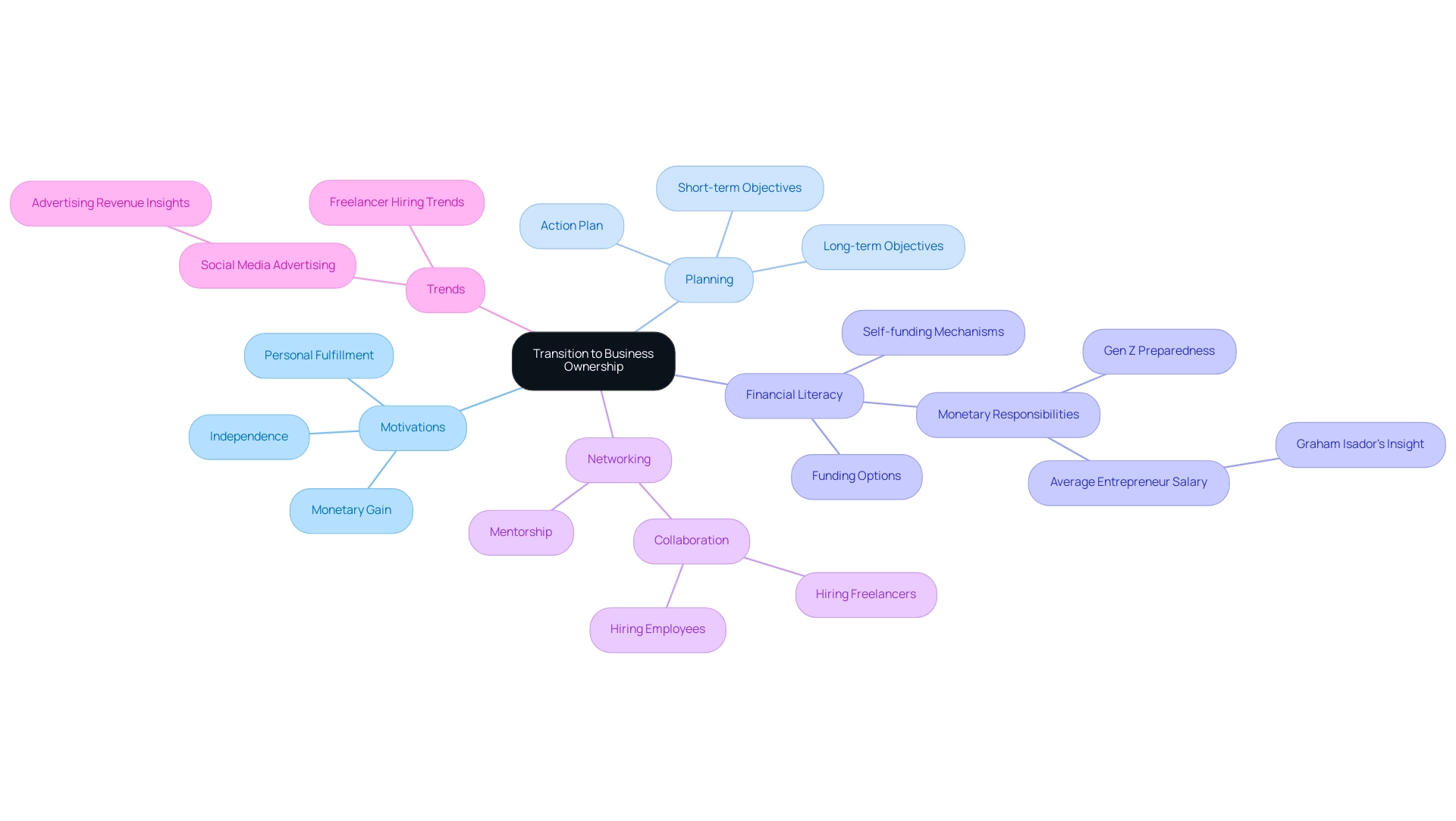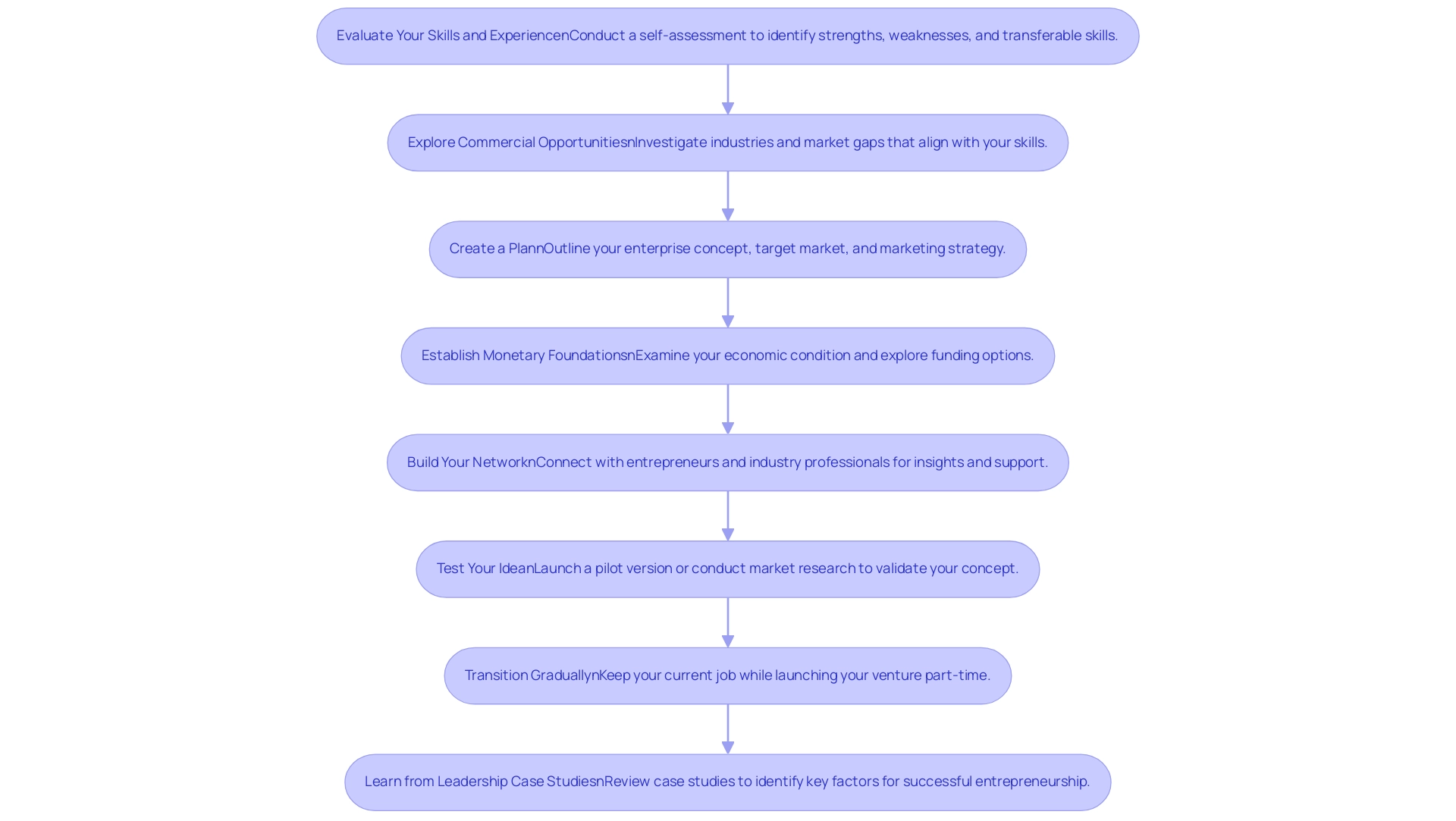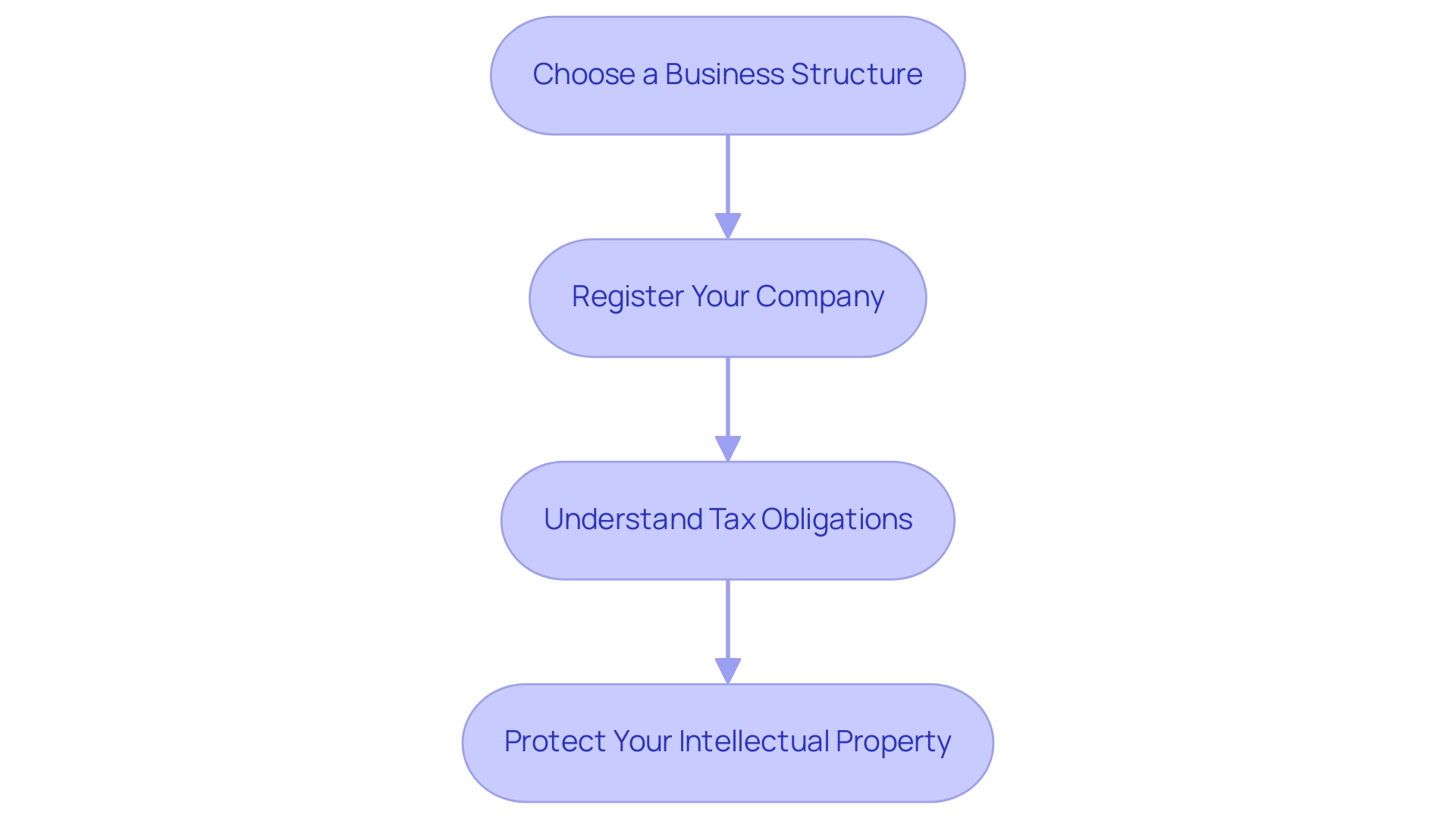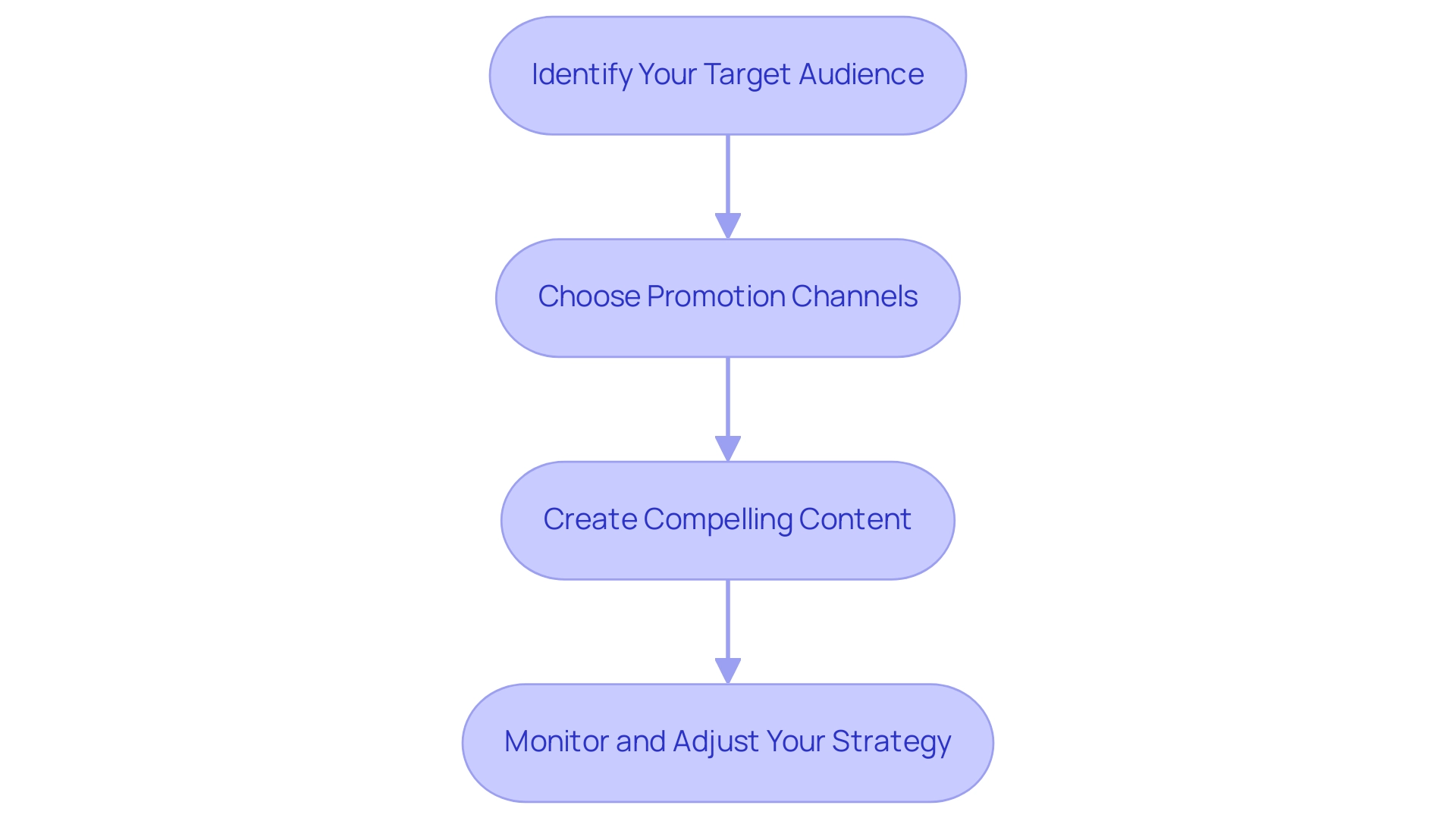Overview
Transitioning from a career to business ownership requires a comprehensive approach that includes self-assessment, strategic planning, and establishing a support network. The article emphasizes the importance of understanding personal motivations, developing a clear business plan, and leveraging mentorship and networking opportunities to navigate the complexities of entrepreneurship successfully.
Introduction
Transitioning from a stable career to the unpredictable world of entrepreneurship is a journey filled with both excitement and challenges. For many, the allure of business ownership stems from the desire for independence, financial success, or the chance to fulfill a lifelong dream. However, this path requires careful preparation and strategic planning to ensure a smooth transition.
From assessing personal motivations and developing a robust business plan to understanding legal requirements and building a support network, each step is crucial in laying a solid foundation for future success.
This article delves into the essential elements that aspiring entrepreneurs must consider, offering practical insights and actionable strategies to navigate the complexities of starting a business.
Preparing for the Transition: Mindset and Planning
Preparing for the best how to transition from career to business ownership begins with a thorough assessment of your motivations. Reflect on what motivates your ambition to own a business—whether it’s the pursuit of independence, the potential for monetary gain, or the fulfillment of personal goals. Embracing a growth mindset is crucial during this phase; view challenges not as obstacles, but as opportunities to learn and expand your capabilities.
To ensure clarity in your journey, develop a detailed action plan that outlines both short-term and long-term objectives, including financial targets and self-funding mechanisms through checking and savings accounts that can support your entrepreneurial ambitions. Consider utilizing services related to self-funding, such as those outlined in the user manuals, to better understand your options. Moreover, consider the value of mentorship; connecting with experienced entrepreneurs can provide invaluable insights and guidance that will enrich your planning process.
Recent trends show that 66% of solopreneurs are looking to hire freelancers or contractors in 2024, indicating a collaborative approach to business growth that you might want to consider. Moreover, with 94% of Gen Z entrepreneurs feeling unprepared to handle monetary responsibilities, prioritizing literacy in this area should be integral to your preparation strategy. As Graham Isador notes, the average entrepreneur makes around $64,000 per year, highlighting the financial realities of entrepreneurship.
Furthermore, advertising constitutes only 1% of the average company’s revenue, yet leveraging social media can allow you to promote your enterprise effectively on various budgets. For further insights and strategies, download the ‘Why work with Parnell’ PDF, which offers additional resources. By establishing a strong foundation through self-reflection, strategic planning, and networking, along with understanding your funding options, you will be better equipped to navigate the complexities of entrepreneurship and discover the best how to transition from career to business ownership.

Key Steps to Transitioning from Employee to Business Owner
- Evaluate Your Skills and Experience: Begin by conducting a thorough self-assessment to identify your strengths, weaknesses, and transferable skills. Reflect on your professional background and consider how these assets can be effectively utilized in your new venture. Recognizing your distinct abilities is essential, as Vimal Sathvara highlights, the key components are also vital in organizational skills: management, marketing, administrative, and legal. Furthermore, it’s important to recognize that in 37 economies, a higher proportion of women than men who see good opportunities would not initiate a venture due to fear of failure. This statistic underscores the psychological barriers that many aspiring entrepreneurs, particularly women, face, and highlights the need for the best How to transition from career to business ownership through a strong self-assessment process to empower oneself. Additionally, addressing the pain points of unfair or disproportionate salaries can motivate individuals to seek better opportunities and financial independence.
- Explore Commercial Opportunities: Investigate various industries and models that resonate with your interests and expertise. Pay close attention to market gaps where you can add significant value—this targeted research will help you align your skills with potential opportunities, ultimately increasing your chances of success in your entrepreneurial journey. Consider the current job market’s limitations, such as age factor constraints, which might affect your employability in traditional roles.
- Create a Plan: A comprehensive plan is essential. It should outline your enterprise concept, target market, competitive analysis, marketing strategy, and revenue projections. This document not only serves as your roadmap but is also instrumental in securing funding, as it helps potential investors understand your vision and the market landscape. A well-organized strategy can also outline how your enterprise will aid in achieving your economic independence, which is considered the best how to transition from career to business ownership, a vital objective for many changing careers.
- Establish Monetary Foundations: Examine your present economic condition to ascertain the resources needed to start your venture. Aim to create a monetary cushion that allows you to support yourself during the initial stages. Explore funding options, including loans and potential investors, to ensure you have the necessary resources to kickstart your enterprise. As you progress, remember that income growth from your venture can alleviate financial stress, allowing you to tackle obligations more comfortably and build wealth over time.
- Build Your Network: Networking is invaluable. Connect with other entrepreneurs, industry professionals, and potential customers to gain insights and support. Engaging with a diverse network can reveal opportunities and collaborations that may not be apparent at first glance, empowering you to navigate the challenges of a changing economy. Community engagement can also provide emotional support as you transition to a new career path.
- Test Your Idea: Before fully committing, consider launching a pilot version of your venture or conducting in-depth market research to validate your concept. Collect feedback from early users, and be ready to make adjustments based on their insights—this iterative process can significantly enhance your model and market fit.
- Transition Gradually: If possible, keep your current job while launching your venture on a part-time basis. This approach reduces monetary risks and enables you to acquire valuable experience in managing dual roles. As your enterprise expands and becomes sustainable, you can confidently pursue the best how to transition from career to business ownership, paving the way for financial freedom and a lifestyle that aligns with your aspirations.
- Learn from Leadership Case Studies: Consider reviewing case studies on entrepreneurial leadership, which identify key factors that define successful entrepreneurs. For example, research has revealed significant differences between founders and non-founders in areas such as comfort with uncertainty, identification of opportunities, and finance management. Learning from these examples can provide you with practical insights into the skills necessary for successful entrepreneurship, helping you to focus on creating the lifestyle of your dreams.

Understanding Legal and Regulatory Requirements
- Choose a Business Structure: Selecting the right structure—be it a sole proprietorship, limited liability company (LLC), or corporation—is crucial to aligning with your goals, managing liability, and understanding tax implications. In 2024, it’s essential to stay informed about the current legal requirements, as over 69% of startups begin as home enterprises, highlighting the significance of making informed choices. Furthermore, grasping the environment of mergers and acquisitions, which involved 2,502 exits in the first half of 2022, can offer valuable insights into the long-term sustainability of your organizational structure. Consulting a legal advisor can provide clarity and ensure that your chosen structure supports your long-term vision.
- Register Your Company: After determining your structure, the next step is to officially register your company name. This process involves obtaining the necessary licenses and permits specific to your industry and location. Be aware that the average costs of enterprise registration can vary significantly, so budgeting appropriately is essential. Understanding the legal landscape will help you navigate potential challenges more effectively, especially considering the common reasons for startup failures, such as inadequate team selection and ineffective competition.
- Understand Tax Obligations: It’s vital to grasp the tax responsibilities associated with your chosen enterprise structure. For instance, office administrative services report an average net profit margin of 11.3%, which underscores the importance of optimizing your tax strategy to maximize profitability. Consulting with a tax professional can enhance your compliance and help you leverage available deductions, ultimately benefiting your bottom line.
- Protect Your Intellectual Property: If your business involves unique ideas or products, it’s important to explore options for intellectual property protection. This could include trademarks, copyrights, or patents, safeguarding your innovations from competitors. Taking proactive measures in this area can be a significant differentiator in a competitive landscape, particularly in industries with high failure rates, such as construction and transportation, where statistics show a 25% failure rate within the first year. Understanding these risks can guide your decisions and strategies as you explore the best how to transition from career to business ownership.

Developing a Marketing Strategy
- Identify Your Target Audience: Begin by clearly defining your ideal customers. Utilize tools like the Claritas Zip Code Lookup to view lifestyle segmentation data for households in the U.S., which can help you create a comprehensive profile based on demographic statistics, interests, and behaviors. Grasping your audience is essential; it enables you to customize your promotional efforts effectively. Notably, 91% of consumers are more likely to shop with brands that recognize and remember them, emphasizing the importance of this step.
- Choose Promotion Channels: With a clear audience in mind, identify which promotion channels will resonate most with them. This can range from social media platforms to email marketing and content marketing. Each channel presents unique advantages; for instance, recent data indicates that 84% of small enterprises report seeing favorable results from their PPC advertising campaigns, showcasing its potential effectiveness when aligned with your target audience.
- Create Compelling Content: Develop engaging content that not only captivates your audience but also showcases your expertise. This could manifest as blog posts, videos, or social media updates that provide value and foster trust. Leveraging technology, such as AI, can enhance your creativity and efficiency during the content creation process. For instance, two-thirds of companies utilize AI for brainstorming sessions, drafts, and outlines, particularly benefiting the initial phases of planning by enhancing creativity and efficiency.
- Monitor and Adjust Your Strategy: Continuously assess the effectiveness of your promotional efforts by tracking key performance indicators (KPIs). This ongoing assessment allows you to adapt your strategy based on what works and what doesn’t, ensuring that your approach remains relevant and impactful as market dynamics evolve. For instance, organizations that regularly analyze their KPIs can identify trends and make informed decisions, leading to improved marketing outcomes.

Establishing a Support System
- Find a Mentor: Connecting with individuals who have successfully navigated the path to entrepreneurship can be transformative. A mentor can offer invaluable insights, share their experiences, and provide encouragement throughout your journey. Organizations such as SCORE and MENTOR are excellent resources for finding seasoned mentors who understand the challenges you may face. Research suggests that entrepreneurs with mentors are considerably more likely to thrive; a recent survey revealed that 70% of small enterprise owners who had mentors reported higher success rates in their ventures. This mentorship fosters necessary skills and confidence, bridging the gap for many aspiring entrepreneurs.
- Join Networking Groups: Engaging with local or online networking groups focused on entrepreneurship can open doors to vital support systems. These communities not only allow for resource-sharing and collaboration but also create a space where you can learn from others’ successes and setbacks. The effect of such networking is profound; statistics reveal that owners who actively network are 50% more likely to report higher levels of satisfaction and success in their ventures, according to Score’s data report series, ‘The Megaphone of Main Street.’
- Engage with Professional Organizations: Consider joining professional organizations relevant to your industry. Such groups often provide essential resources, training, and networking opportunities specifically designed for new entrepreneurs. By participating, you can access tools and information that can significantly enhance your acumen and market knowledge.
- Utilize Online Resources: The digital landscape offers a wealth of platforms, webinars, and courses dedicated to entrepreneurship. Embracing continuous learning through these online resources can help you stay informed and agile in adapting to the ever-evolving commercial environment. As Michael Litt, founder and CEO, emphasizes, the right educational resources can empower entrepreneurs to make informed decisions and foster innovation in their ventures.
- Explore Self-Funding Options: For aspiring entrepreneurs, self-funding through checking and savings accounts can provide a solid economic foundation. This approach allows you to maintain control over your business without incurring debt or relinquishing equity. The U.S. Small Business Administration provides various funding options that can enhance your self-funding strategy, including loan programs and educational resources. Additionally, consider cash equivalents such as money market accounts or short-term investments, which can provide liquidity while contributing to your self-funding strategy. By utilizing these resources, you can lay a strong financial groundwork for your entrepreneurial journey.

Conclusion
Transitioning from a stable career to entrepreneurship presents both significant opportunities and challenges. By thoroughly assessing personal motivations and embracing a growth mindset, aspiring business owners can develop a solid foundation for their journey. Crafting a detailed action plan, evaluating skills, and conducting market research are essential steps that pave the way for success. A comprehensive business plan not only serves as a roadmap but is also vital for securing funding and guiding strategic decisions.
Understanding legal and regulatory requirements is critical in establishing a business that thrives. Choosing the right structure, registering the business, and grasping tax obligations can protect against potential pitfalls. Additionally, creating a robust marketing strategy that identifies target audiences and leverages effective channels will enhance visibility and engagement.
Building a support system through mentorship and networking is invaluable for navigating the complexities of entrepreneurship. Engaging with experienced individuals and groups fosters learning, collaboration, and emotional support, which can significantly impact success rates.
Ultimately, the journey into entrepreneurship is one of careful planning, informed decision-making, and resilience. With the right strategies in place, aspiring entrepreneurs can turn their dreams into reality, achieving both financial independence and personal fulfillment. The path may be challenging, but with determination and the right resources, success is within reach.
Frequently Asked Questions
What is the first step in transitioning from a career to business ownership?
The first step is to conduct a thorough assessment of your motivations for wanting to own a business. Reflect on whether your ambition is driven by independence, monetary gain, or personal fulfillment.
Why is a growth mindset important during the transition to business ownership?
Embracing a growth mindset is crucial as it allows you to view challenges as opportunities for learning and expanding your capabilities, which is essential for navigating the entrepreneurial journey.
How can I create an effective action plan for my business transition?
Develop a detailed action plan that outlines both short-term and long-term objectives, including financial targets and self-funding mechanisms, to support your entrepreneurial ambitions.
What role does mentorship play in the transition to business ownership?
Mentorship provides invaluable insights and guidance from experienced entrepreneurs, enriching your planning process and helping you navigate the complexities of entrepreneurship.
What recent trends should aspiring entrepreneurs be aware of?
Recent trends indicate that 66% of solopreneurs are looking to hire freelancers or contractors in 2024, suggesting a collaborative approach to business growth.
What financial literacy considerations should I keep in mind?
Prioritizing financial literacy is integral, especially since 94% of Gen Z entrepreneurs feel unprepared to handle monetary responsibilities. Understanding financial realities is crucial for successful entrepreneurship.
How can social media be utilized in promoting a new business?
While advertising constitutes only 1% of the average company’s revenue, leveraging social media can effectively promote your enterprise on various budgets.
What steps can I take to evaluate my skills and experience before starting a business?
Conduct a thorough self-assessment to identify your strengths, weaknesses, and transferable skills, and consider how these assets can be utilized in your new venture.
How can I explore commercial opportunities related to my interests?
Investigate various industries and models that resonate with your expertise, paying attention to market gaps where you can add significant value.
What should be included in my business plan?
Your business plan should outline your enterprise concept, target market, competitive analysis, marketing strategy, and revenue projections to serve as a roadmap and assist in securing funding.
How can I establish a monetary foundation for my new venture?
Examine your current economic condition to determine the resources needed, create a monetary cushion for the initial stages, and explore funding options such as loans and potential investors.
Why is networking important for aspiring entrepreneurs?
Networking with other entrepreneurs and industry professionals can provide insights, support, and reveal opportunities and collaborations that may not be immediately apparent.
What is the benefit of testing my business idea before full commitment?
Launching a pilot version or conducting market research allows you to validate your concept and collect feedback for adjustments, enhancing your model and market fit.
How can I transition gradually into business ownership?
If possible, keep your current job while launching your venture part-time to reduce financial risks and gain valuable experience in managing both roles.
How can case studies on entrepreneurial leadership help me?
Reviewing case studies can provide practical insights into the skills necessary for successful entrepreneurship, helping you focus on creating the lifestyle of your dreams.


